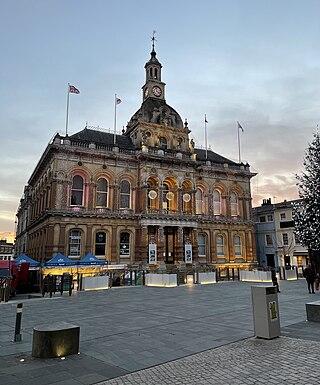
Tattershall Castle is a castle in Tattershall, Lincolnshire, England, Since 1925 it has been in the care of the National Trust.

The Foss Dyke, or Fossdyke, connects the River Trent at Torksey to Lincoln, the county town of Lincolnshire, and may be the oldest canal in England that is still in use. It is usually thought to have been built around AD 120 by the Romans, but there is no consensus among authors. It was refurbished in 1121, during the reign of King Henry I, and responsibility for its maintenance was transferred to the city of Lincoln by King James I. Improvements made in 1671 included a navigable sluice or lock at Torksey, and warehousing and wharves were built at Brayford Pool in the centre of Lincoln.

East Riddlesden Hall is a 17th-century manor house in Keighley, West Yorkshire, England, now owned by the National Trust.

Gainsborough is a market town, inland port and civil parish in the West Lindsey district of Lincolnshire, England. The town population was 20,842 at the 2011 census, and estimated at 23,243 in 2019. It lies on the east bank of the River Trent, 18 miles (29 km) north-west of Lincoln, 16 miles (26 km) south-west of Scunthorpe, 20 miles south-east of Doncaster and 39 miles (63 km) east of Sheffield. It is England's furthest inland port at over 55 miles (89 km) from the North Sea.

Alkborough is a parish of 471 people in 192 households in North Lincolnshire, England, located near the northern end of The Cliff range of hills overlooking Trent Falls, the confluence of the River Trent and the River Ouse.
Lincolnshire, England derived from the merging of the territory of the ancient Kingdom of Lindsey with that controlled by the Danelaw borough Stamford. For some time the entire county was called 'Lindsey', and it is recorded as such in the Domesday Book. Later, Lindsey was applied to only the northern core, around Lincoln; it was defined as one of the three 'Parts of Lincolnshire', along with Holland in the south-east and Kesteven in the south west.

Lincoln Castle is a major medieval castle constructed in Lincoln, England, during the late 11th century by William the Conqueror on the site of a pre-existing Roman fortress. The castle is unusual in that it has two mottes. It is one of only two such castles in the country, the other being at Lewes in East Sussex. Lincoln Castle remained in use as a prison and court into modern times and is one of the better preserved castles in England; the Crown Courts continue to this day. It is open to the public most days of the week and possible to walk around the walls from which there are views of the castle complex, cathedral, the city, and surrounding countryside. Displayed within the castle is one of only four surviving exemplars of the Magna Carta of 1215. The castle is now owned by Lincolnshire County Council and is a scheduled monument.

Marton is a village and civil parish in the West Lindsey district of Lincolnshire, England. It is situated at the junction between the A156 and the A1500. It is 5 miles (8 km) south of Gainsborough, and 11 miles (18 km) north-west of Lincoln. The population of the civil parish was 747 at the 2011 census. The parish borders Brampton, Gate Burton, Sturton by Stow, North Leverton with Habblesthorpe, Cottam, Sturton-le-Steeple and Willingham.

Torksey is a small village in the West Lindsey district of Lincolnshire, England. The population of the civil parish at the 2011 census was 875. It is situated on the A156 road, 7 miles (11 km) south of Gainsborough and 9 miles (14 km) north-west of Lincoln, and on the eastern bank of the tidal River Trent, which here forms the boundary with Nottinghamshire.

Somerton Castle is located approximately 1 mile (1.6 km) west of the village of Boothby Graffoe in Lincolnshire, England and to the south of the city of Lincoln, England. The site is on low-lying land between the Lincoln Edge and the River Witham. Although Somerton Castle is in the parish of Boothby Graffoe, it is in the Manor of Waddington and this portion is often referred to as the Manor of Somerton Castle. Antony Bek probably built the castle in 1281 and he gave it to King Edward II in 1309. King John II of France was imprisoned at Somerton Castle between 1359 and 1360, having been taken prisoner after the Battle of Poitiers. It continued as crown property until it was sold by Charles I in 1628, since when the castle has continued in private ownership.

Moreton Corbet Castle is a ruined medieval castle and Elizabethan era manor house, located near the village of Moreton Corbet, Shropshire, England. It is a Grade I listed building and English Heritage property. Although out of use since the 18th century, it remains the property of the Corbet family. It can be visited free of charge during daylight hours.

The A156 is an 11 miles (18 km) long road that runs from the A57 near Saxilby and heads north to Gainsborough. The road runs entirely within Lincolnshire right next to the border with Nottinghamshire. It is a single carriageway for its entire length apart from one small stretch at Torksey Lock where the A1133 joins from Newark-on-Trent.

The siege of Lincoln took place from 3 to 6 May 1644 during the First English Civil War, when the important town of Lincoln was besieged by Parliamentarian forces under the Earl of Manchester. On the first day, the Parliamentarians took the lower town. The Royalist defenders retreated into the stronger fortifications of the upper town, which encompassed and incorporated Lincoln Castle and Lincoln Cathedral. The siege ended four days later when the Parliamentarian soldiers stormed the castle, taking prisoner the Royalist governor, Sir Francis Fane, and what remained of his garrison.

Newton on Trent is a village and civil parish in the West Lindsey district of Lincolnshire, England. The population of the civil parish at the 2011 census was 389. The village is situated east of the River Trent, and is 10 miles (16 km) south of Gainsborough, 10 miles (16 km) west of Lincoln, and at the junction of the A57 running east to west, and the A1133 running north to south.

William Adams Nicholson (1803–1853) was an English architect who worked in Lincoln and was a founding member of the Royal Institute of British Architects.

William Haywood was an architect who worked in Lincoln, England. His father John who died in 1817 was mayor of Lincoln twice and worked as a mason. Haywood succeeded his father as mayor after his death in 1817. His grandfather, John Hayward (1708–78) was also a mason in Lincoln. William Hayward's great grandfather was Abraham Haywood an architect of Whitchurch, Shropshire who came to Lincoln around 1720. William Haywood succeeded William Lumby as Surveyor to Lincoln Cathedral in 1799 and Edward James Willson followed him in this position in 1823. William Hayward also succeeded William Lumby as Surveyor for the Lincolnshire County County Committee, which had responsibility for Lincoln Castle and the prison. Howard Colvin considered Hayward to be a competent designer in the ‘Regency’ style and that from the re-construction of Kirton in Holland church in 1804 had an understanding of Gothic architecture quite remarkable at that date. Hayward also rebuilt the tower of Wrangle church in a similar style in 1820.

Henry Goddard was an English architect who was a member of a family of architects who worked in Leicester. He moved to Lincoln and was later in partnership with his son Francis Henry Goddard.

Bellamy and Hardy was an architectural practice in Lincoln, England, that specialised particularly in the design of public buildings and non-conformist chapels. Pearson Bellamy had established his own architectural practice by 1845 and he entered into a partnership with James Spence Hardy in June 1853. Both partners had previously worked for the Lincoln architect William Adams Nicholson. Hardy was described as "Chief Clerk" to Nicholson. Hardy joined Pearson Bellamy immediately after the sudden death of Nicholson. As all known architectural drawings by the practice are signed Pearson Bellamy, it is likely that Bellamy was the architect and Hardy was the administrator in the practice. The partnership lasted until 1887. Bellamy continued to practise until 1896.

The following is a timeline of the history of the city of Lincoln, the county town of Lincolnshire in the East Midlands of England.

Rampton and Woodbeck is a civil parish in the Bassetlaw district, within the county of Nottinghamshire, England. The overall area had a population of 1,077 at the 2021 census. The parish lies in the north east of the county. It is 125 miles north west of London, 27 miles north east of the city of Nottingham, and 5 miles south east of the town of Retford. The parish rests alongside the county border with Lincolnshire. It is the site of Rampton Secure Hospital, which is one of only three high security psychiatric hospitals in England.























